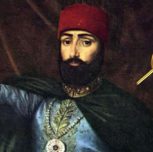(1830, 1861-1876)
When Abraham Lincoln (1809, 1861-1865), became the 16th president of the USA in the spring of 1861, on the other side of the Atlantic, a new leader came to the world diplomatic stage; Sultan Abdülaziz, the 32nd Sultan of the Ottoman Empire.
Sultan Abdülaziz, born on 8 February 1830, was the younger son of Sultan Mahmud II (1808-1839). He was 9 years old when his father died. He was raised by his mother, Pertevniyal Valide Sultan (1812-1883).
During the reign of his brother Sultan Abdülmecid (1839-1861), he lived under the protection and supervision of the Sultan, as he was the first in line to the throne. Therefore, his life was safe, but his flexibility and freedom were limited. He received an excellent education, particularly in languages, sports, such as wrestling, and music.
With the unexpected death of his brother, Abdülmecid, on 25 June 1861 at the age of 39, 31-year-old Abdülaziz was brought to the throne as 32nd sultan. Declaring the validity of the Letter of Tanzimât, which guaranteed the rights and reforms since Abdülmecid, was one of his first accomplishments as a sultan. Like his father and brother, a personal march was composed for him. Ottoman-Italian Callisto Guatelli composed the “Aziziye Marşı” in 1861. This march was used as an anthem until the end of his reign.
The Ottoman Bank, established in 1856 by a private British investment, received a privileged status in 1863 to act as a central bank issuing banknotes (kaime), organizing foreign loans, etc. The first one-lira banknote bearing the date of 1875 was issued on 15 July 1880. The note carried inscriptions in five languages. Besides Turkish and French, as usual, the note also had inscriptions in Greek, Armenian and Arabic.
His Travel Overseas
Achieving successful relations with foreign countries was an important state goal for Abdülaziz. Traveling overseas for diplomatic visits was not a tradition for Ottoman Sultans. His father, Mahmud II, made the first travel within the Ottoman land; Abdülaziz had to make the trip overseas. Therefore, he changed the tradition and arranged some major state visits in the East and West, not only for himself, but also for his close circle including Abdülmecid’s sons Murad V (1876) and Sultan Abdülhamid II (1876-1909), the first and the second in line to the throne.
Abdülaziz made his first trip overseas in 1863 to Egypt, which was then a part of the Ottoman Empire. In 1867, he visited Napoleon III in France, Queen Victoria in England, King Leopold in Belgium, and Emperor Francois Joseph in Austria, becoming the first and comprehensive travels of an Ottoman Sultan in Europe. The 46-day trip was a great success. These trips to Europe and Egypt were culturally and politically significant experiences for him, his nephews and his envoy. They were all impressed by the people, buildings and lifestyles in those countries.
The reflection of his trips can be seen in his palaces. One was built in the western style, and the other in the Eastern style. Abdülaziz started to construct two new palaces almost at the same time in 1863. Facing each other on the opposite sides of Bosphorus, they were in the neighborhoods of Beylerbeyi on the Asian side and Çırağan on the European side. He completed the Beylerbeyi Sarayi, which was in French neo-baroque style with a traditional Ottoman plan, in two years in 1865 and used it as a summerhouse. He resided in Dolmabahçe Palace in winters and lived in the Beylerbeyi Palace in summers. It took 8 years to complete the Çırağan Palace, which was in North African Islamic architectural style, and was completed in 1871. Abdülaziz never lived in the Çırağan Palace, as there was a Mevlevi Lodge and its cemetery on the land of the palace previously, and he was afraid of a possible curse from its former occupant.
During the reign of Abdülaziz, there were many developments globally. The American Civil War (1861-1865) between the North (Union) and the South (Confederacy) ended with the victory of the North. Caused by eleven Southern slave states declaring secession, the bloody war created the slave-free United States of America.
It was a period when the social and political life was affected by Karl Marx's “Das Kapital“(1867), and Charles Darwin's “The Descent of Man” (1871). Militarily, Alfred Nobel invented the safe means of handling dynamite in 1867. The first typewriter, the Hansen Writing Ball, invented by Rasmus Malling-Hansen of Denmark, went into commercial production in 1870. In addition, a group of French artists, led by Claude Monet’s work in 1872, “Impression, Soleil Levant” (Impression, Sunrise), initiated the new wave of an art movement called “Impressionism”.
Abdülaziz initiated one of the first railroad projects in the Empire. He completed the first section of the Sirkeci Train Station in Istanbul in 1871, which was mentioned as the last station in the worldwide known novel, the Orient Express by Agatha Christie.
Parliamentary Monarchy
Upon the death in 1871 of Âli Paşa, the Grand Vizier and his close confidant, Abdülaziz fell into limbo. The empire lacked qualified statesmen, heading into a big financial crisis, which peeked in 1875. Independence movements in the Balkans in 1876 added more problems to the Empire. It was then believed that the best strategy for the Empire was to change the political system to the “constitutional monarchy”. It would be possible only if Sultan Abdülaziz was replaced with Murat V, Abdülmecid’s son. Accordingly, Sultan Abdülaziz was dethroned on 30 May 1876 and Murad V became sultan the same day.
His Final Years
Sultan Abdülaziz and his family were first taken from the Dolmabahçe Palace to the Topkapı Palace, but afterwards were taken to the Feriye Apartments in the Çırağan Palace complex. The tragic death of Sultan Abdülaziz on 5 June 1876 left many unanswered questions. 46-year-old Sultan was found dead in his room in Feriye, with his wrists cut. It is unknown if it was a suicide or an assassination, but it is obvious that it was a dark, sad day for his mother, Pertevniyal Valide Sultan who was then 64 years old.
Pertevniyal Valide Sultan (1812-1883), was a beautiful, philanthropist and good-hearted person. She invested in 1872 the money, granted by her husband for her future safety, in education and established an elementary-middle school (sübyan and Rüştiye) called "Mahmûdiye Rüştiyesi" in Aksaray, Istanbul. Afterwards, the name of the school changed to Pertevniyal High School. Burned down in 1911, the school was rebuilt in 1930. Today, it is among the most prominent high schools in Istanbul. The other important investment was in religion. She built in 1871 the Pertevniyal Valide Sultan Camii, designed by the Italian architect Montani in empirical styles. Located in Aksaray of Istanbul, the square-planed mosque contains the private mausoleum of Pertevniyal Valide Sultan.
Sultan Abdülaziz was buried in the Mausoleum of Mahmud II (2. Mahmud Türbesi), where his father Sultan Mahmud II and his nephew Sultan Abdülhamid II were also buried in 1839 and 1918, respectively. The octagonal mausoleum (türbe) with marble exterior is located in the Çemberlitaş neighborhood of the Eminönü District in Istanbul.
Nejat Gök, (2012), Abdülaziz’in Avrupa Seyahati ve Sonuçlari. Tarihin Peşinde, Issue 7, p 165-188.
The New York Times, 5 August 1869, “Proposed Visit of Eugenie to Constantinople”










